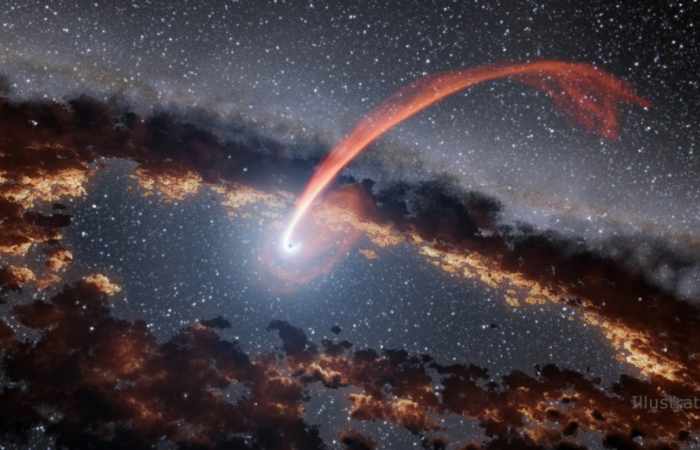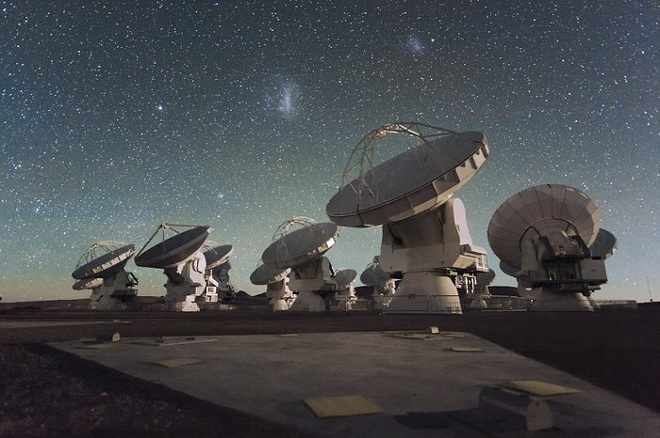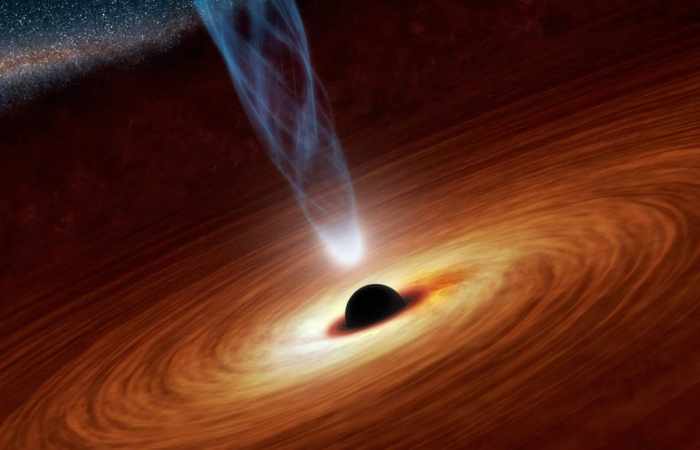It is the stuff of physicists' wildest dreams.
“Black holes are basically the most mysterious objects in the cosmos,” said Shep Doeleman, an astronomer at the Harvard-Smithsonian Center for Astrophysics. Even Albert Einstein almost didn't believe they were real, even though it was his theory of general relativity that helped predict them more than 100 years ago.
In the century since, scientists have been able to sense black holes through observations of their influence on nearby matter. And with last year's detection of gravitational waves emitted by two colliding black holes, they've also heard them. But no one has ever seen a black hole. The enigmatic objects hide behind an “event horizon” — the boundary at which gravity acts like an invisibility cloak, wrapping around light and matter and swallowing them whole. No telescope on Earth is powerful enough to penetrate that abyss.
At least, no single telescope is. On Wednesday night, a battalion of 120 astronomers working at eight observatories on four continents will mobilize in an unprecedented effort to image the black hole at the center of the Milky Way, a body named Sagittarius A*. By combining observations from points across the globe, they'll create a virtual observatory the size of Earth itself. The “Event Horizon Telescope,” they call it.

This artist's impression shows a glowing stream of material from a star as it is devoured by a supermassive black hole. (NASA/JPL-Caltech)
If all goes according to plan, the EHT should capture the dark silhouette of Sagittarius A* against the hot, glowing material that surrounds it, offering the first-ever glimpse at a black hole's event horizon. The resulting snapshot could confirm our understanding of the laws of the universe — or upend it.
“It's a very bold and gutsy experiment,” Stanford University theoretical astrophysicist Roger Blandford, who is not involved in the project, told Science last month. “It will validate this remarkable proposition: that black holes are common in the universe. Seeing is believing.”
Sagittarius A*, like other supermassive black holes, was probably formed during the earliest days of the universe. It is about 4 million times as hefty as the sun but only 18 times as large, and it sits on space-time like a bowling ball on a trampoline, warping everything around it. Under these extreme conditions, the laws of physics are pushed to their limits: Gravity is twisted; light is torn apart like taffy; matter is made to vanish from existence. Doeleman, the EHT's director, calls black holes “the most exotic animals in the cosmological zoo.” Studying what they eat and how they behave can teach scientists a great deal about the workings of the universe, he said.
But feeding time is a messy affair. As Sagittarius A* slurps up matter from the boiling buffet of gas, dust and bits of stars swirling around it, it flings huge amounts of material back into space: X-rays, radio waves, jets of ultrahot gas. Paradoxically, all this activity makes the black hole one of the brightest things in the Milky Way — and further obscures the darkness inside.
An X-ray flare at Sagittarius A*. (D. Haggard et al./NASA/CXC/Amherst College)
If Doeleman and his colleagues want to get a glimpse of the event horizon itself, they can't study the black hole in visible light wavelengths since those are lost in the chaos of the accretion disk. Instead, they must examine it using high frequency radio waves, which can penetrate the wall of glowing gas, traverse 26,000 light-years of the interstellar medium, pass through Earth's atmosphere and be detected by telescopes on the ground.
But no radio telescope on Earth is large enough to take a high-resolution image of an object that far away. Though Sagittarius A* is big — and its distortion of gravity makes it appear even bigger (an effect called “lensing”) — it would still appear to Earthlings as an orange on the moon. Since an instrument's magnifying power is equal to the size of its collecting dish, scientists would need a telescope the size of Earth to make such a dark, distant object visible.
With little chance of the world's governments banding together to build an Earth-sized telescope, Doeleman and his colleagues are using a technique called very-long-baseline interferometry, or VLBI. “Basically, that's a word salad for linking radio dishes around the globe to act as one large telescope,” he said.

The Atacama Large Millimeter/submillimeter Array (ALMA) in Chile, one of the eight observatories that constitute the Event Horizon Telescope. (C. Malin/ESO)
Over five nights during a 10-day window beginning Wednesday, the eight telescopes of the EHT will swivel as one toward the center of the galaxy. Scientists in Chile's Atacama Desert, on a volcano top in Hawaii, at the frozen expanse of the South Pole and in the high, dry mountains of Arizona, Mexico and Spain will be ready to catch the data. If conditions are exactly right at each location — skies clear, instruments working — then Doeleman will give the signal to start observing.
In addition to Sagittarius A*, the EHT will target a second, even more massive black hole in neighboring galaxy M87.
Once they get their five nights of observations, the astronomers around the globe will deliver their findings to supercomputers at the Massachusetts Institute of Technology and the Max Planck Institute in Germany. Doeleman expects to have two to three petabytes of data to look through — equivalent to the storage capacity of about 10,000 MacBooks. It will take the researchers months, if not years, to analyze all the findings.
“VLBI is the ultimate in delayed gratification,” Doeleman said. “You can’t even know if your system is working properly until weeks and months after, when you combine the signals from all the different telescopes.”

The black hole Sagittarius A* appears as a large bright spot in the orange cloud of dust at the center of the Milky Way. (D. Haggard et al./(NASA/CXC/Amherst College)
Team members hope to get their first glimpse of real science this fall, and they have no idea what they might see. If predictions based on modern physics are correct, Sagittarius A* should appear as a bright ring of light (from fast-moving photons orbiting the black hole) with a dim interior. But if scientists are wrong about the way the universe works, this is where they'll find out.
“It’s the most exciting proving ground, the most stringent test of Einstein’s theories,” Doeleman said. “The best result is we learn something very interesting, and it poses the next set of questions.”
/The Washington Post/
More about: #blackhole #science
















































